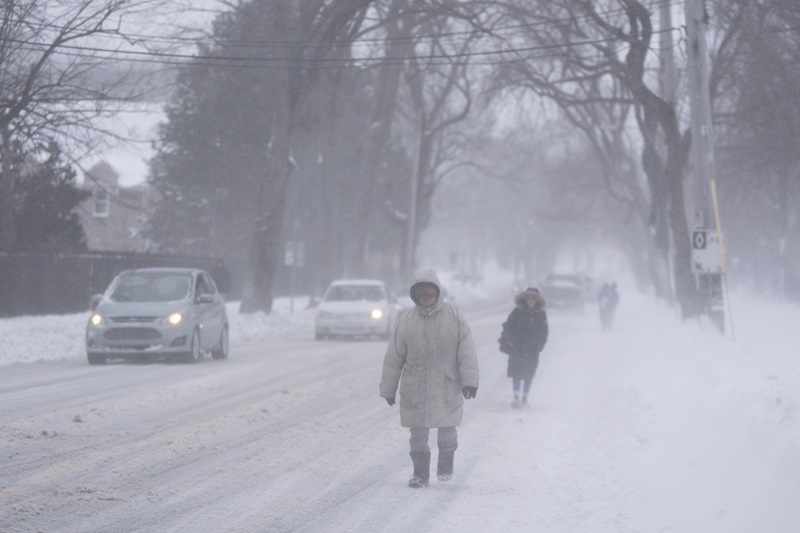How winter storms tally this year compared to last

Maritimers were digging out for days after historic levels of snowfall dropped atop Nova Scotia and P.E.I. in early February.
The multi-day storm produced nearly 5 feet of snow in Cape Breton, N.S. Then about two weeks later, Nova Scotians were again dumped on by snow squalls upward of 37 cm in parts of the province.
But despite the broken records and frenzied media headlines in the wake of the storm, property damages were business as usual, says Peter Keefe, director of operations for Atlantic Canada at First Onsite.
“There was no freeze event or heavy rains following the snow, which really changes the outlook of the whole event,” says Keefe. “So, it ends up just being a real nuisance because of the roads not being cleared, as well as sidewalks being jammed up.
“We are seeing a lot of people where their furnace has stopped working simply because the chimney was buried in snow so it couldn’t breathe anymore,” and this could result in a risk of freezing, Keefe explains, but “most of the problems end up being fairly quickly resolved, because it’s just a matter of the volume of snow affecting the outside of the home.”
It’s not just Halifax that’s been relatively underwhelmed by Cat claims this winter.
“Winter season is usually the slowest season in Canada for Cats,” says Caroline Floyd, director at Catastrophe Indices and Quantification Inc. (Cat IQ). “I would say we usually have two or three Cats every winter.”
Across Canada, P&C insurers have tallied only two catastrophes so far in 2024, according to Floyd. (A Cat is defined as an event that results in more than $30 million in insured loss for the industry, per Cat IQ. A ‘notable event’ is one that causes an estimated $15 million to $30 million in insured loss.)
This perhaps is a welcome relief from the 24 catastrophes the industry faced in 2023. (For the record, 11 is the average number of Cats in a year, Cat IQ’s president and CEO Laura Twidle told attendees at the CatIQ Connect event in February.)
The first catastrophe recorded by CatIQ this winter occurred in December after a storm that originated in the eastern U.S. tracked through Quebec and the Maritimes.
Quebec City and its surrounding areas saw a month’s worth of heavy rain fall in less than 24 hours, prompting evacuations as snow melted and rivers rose. Insurers responded to damage caused by basement seepage, flooding, downed trees and power outages from this event.
“The street was covered in several inches of water so the sewers were not able to keep up,” Anita Paulic, director of operations and catastrophe response at ClaimsPro, says of the storm damage in Quebec.
The second recorded Cat occurred Jan. 12 when an extreme cold event swept the western prairies of Saskatchewan, Alberta and British Columbia. Damages are estimated to have cost insurers over $180 million, CatIQ reports.
During this event, temperatures in parts of B.C. dipped as low as -40 Celsius. In Edmonton, temperatures reached -45 Celsius. Such temperatures are well below seasonal averages.
“With that came a lot of pipe bursts and pipe freezing incidents,” Floyd says.
The deep freeze also brought hazardous road conditions and closed schools.
“Side streets were absolutely treacherous for several days,” Paulic says. “There was one or two days where we were almost immobile.”
These two Cats took place at very different points on the temperature scale, but both have cost the industry.
Comparatively, last winter saw only one Cat — an Atlantic Canada cold snap in February that cost the industry $120 million in damages — and one notable ice storm event in Southwestern Ontario.
Yet, after how active 2023 was for Cats year-round, this winter’s low Cat activity has been a welcome relief for the industry.
But, says Floyd, “I don’t have a lot of faith that it means that the rest of the year will be quiet.”
Pedestrians make their way down Bell Road as heavy snow and gusting winds continue to hit Halifax on Sunday, Feb. 4, 2024. Environment Canada has maintained weather alerts across Nova Scotia with predictions anywhere from 30 to 100 centimetres of snow in parts of the province. THE CANADIAN PRESS/Darren Calabrese







